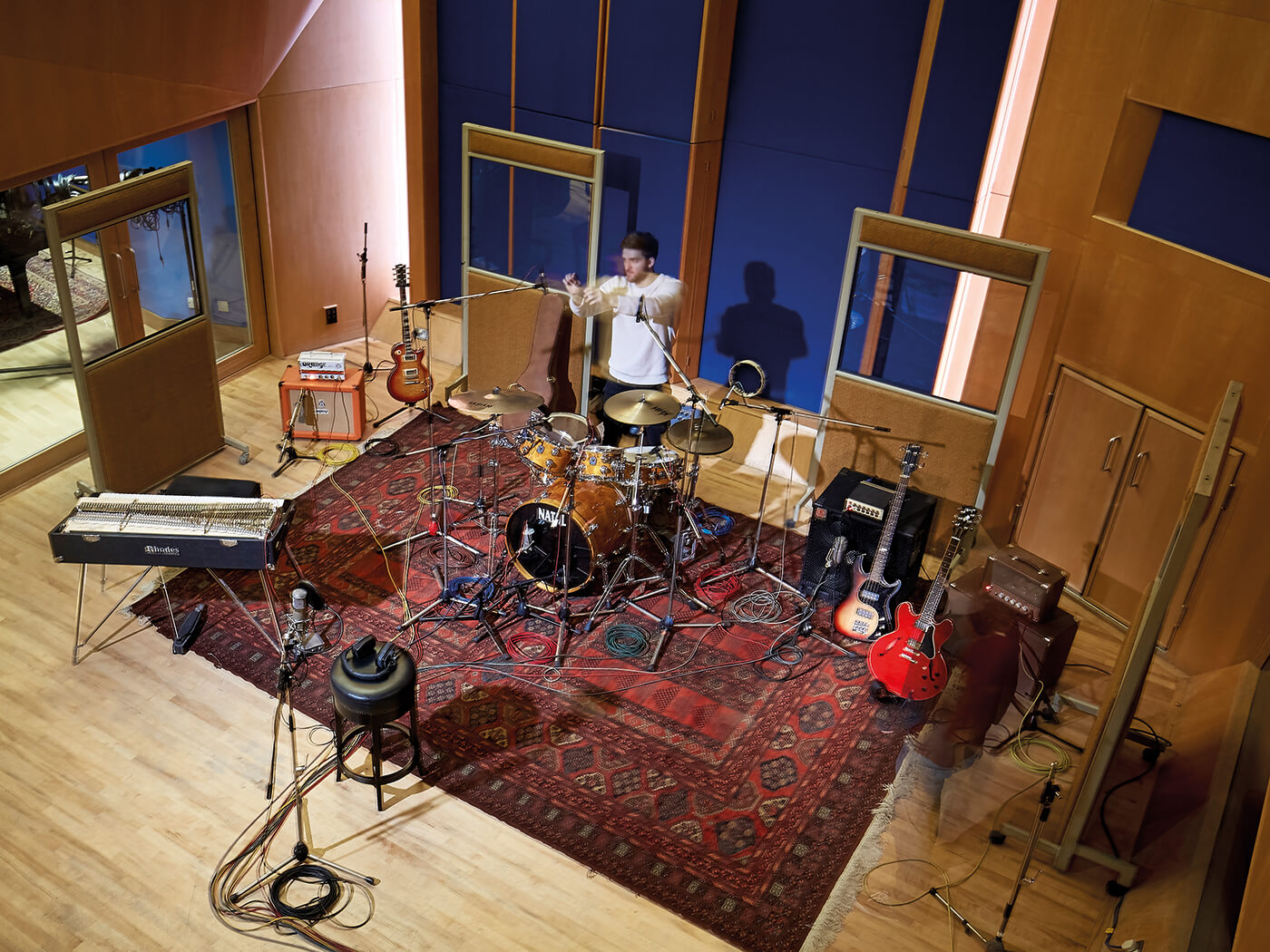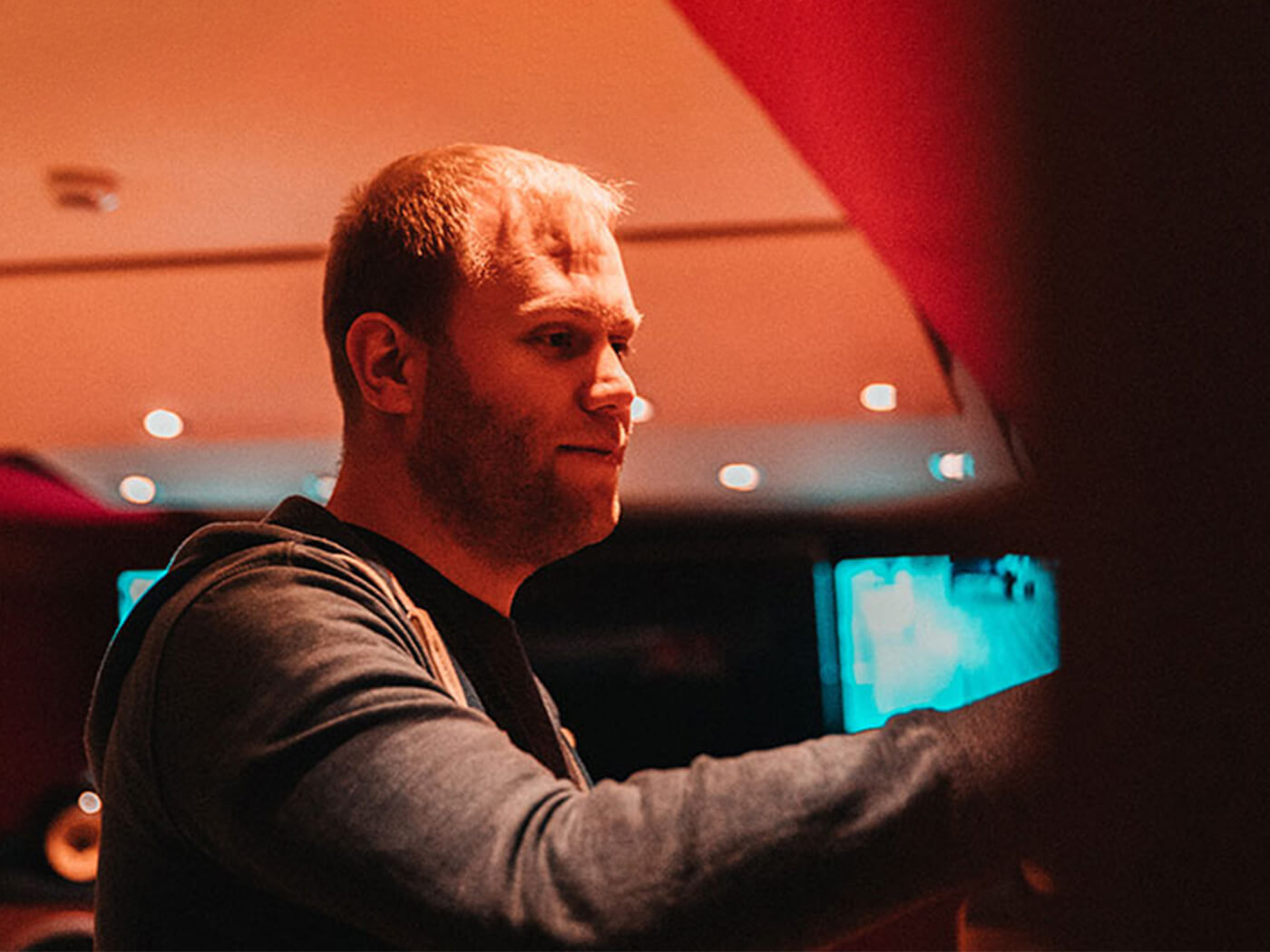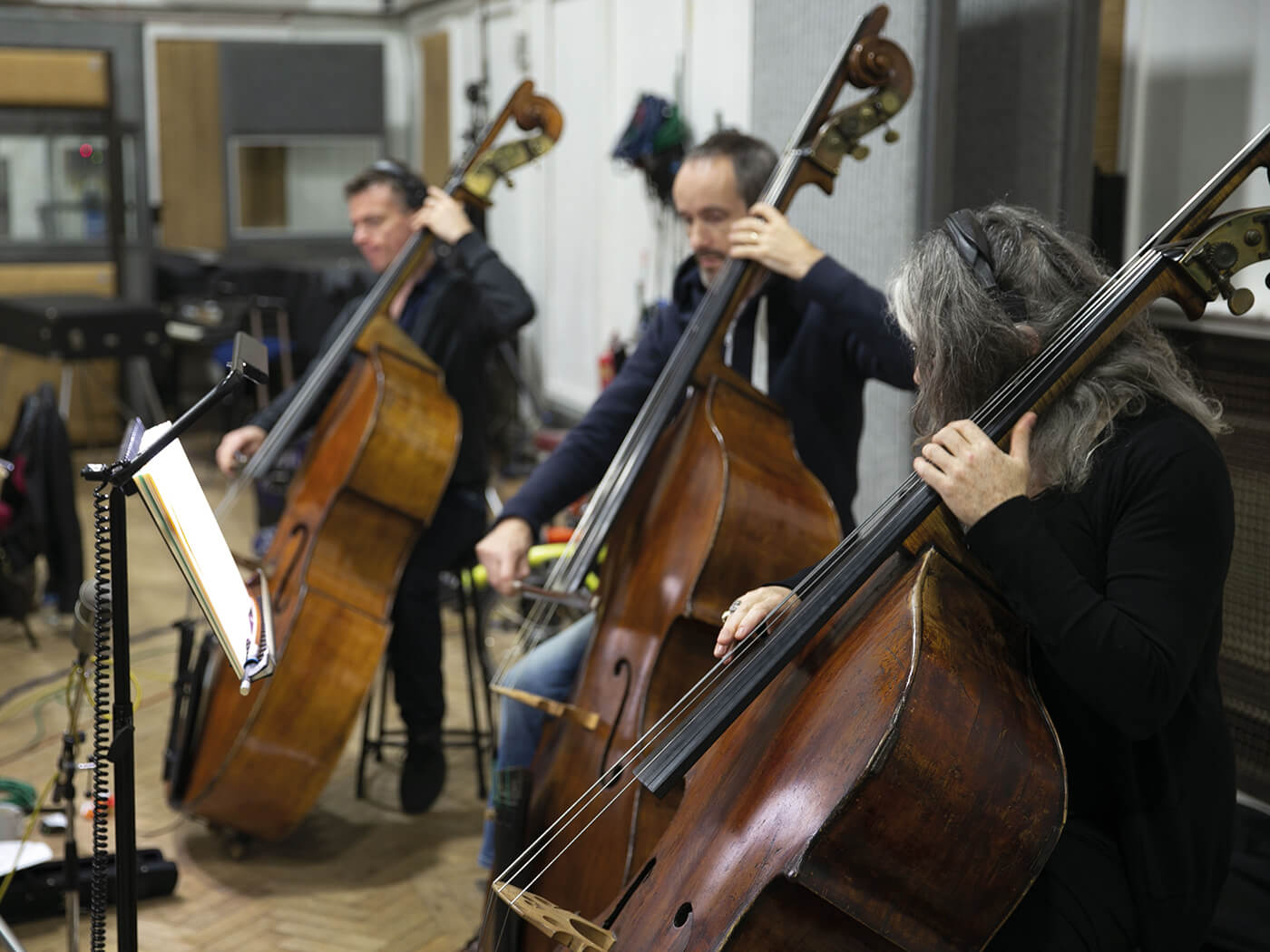Read all the instalments of Ask Abbey Road here.
Ask Abbey Road: Recordist Matt Jones on drum recording and session stoppers
He also shares what it was like working on the David Attenborough Netflix documentary Our Planet.

Miking up a drum-kit is a matter of preference, just make sure you ask the drummer whether your mics are in their way.
This is the final instalment of a three-part interview with Abbey Road recordist Matt Jones. In the previous interviews, Jones shared details of a recordist’s job scope, the importance of having a checklist and lets us in on his sidechain tricks and tips.
Jones began working at Abbey Road in 2012 straight out of university, rising through the ranks from runner to an assistant and now to recordist. Here, he discusses how to mic a drum kit, working on the David Attenborough Netflix documentary Our Planet, and how to solve a technical problem in the studio.
Edward: Is there a way of mic’ing up the drum kit that you prefer over any other?
Matt Jones: I think with drums more than any other thing, it’s easy to get carried away and put out too many mics. You can end up with loads that you don’t use, or you feel compelled to use them in a mix, but actually, they don’t really bring anything to the sound.
As soon as you start having several pairs of room mics in different places, and then you bring out all these weird mono mics and stuff that you think might be fun, suddenly you’ve just got a 30-track-wide, phase-y mess. And no time on the session to actually get any of the mics in the right position. Though it’s fun to experiment with a new mic technique or two each time, it’s always good to make sure that it’s the last thing you pay attention to once your foundation is solid.
As far as that foundation goes, it varies from genre to genre and kit to kit. But I often find myself using Neumann U 67s or similar as overheads, and they just sound nice and full and compress in a good way if the drummer is hitting properly. I try to keep them reasonably low to avoid too much room on those. Obviously, close mics on all the individual drums, too.
For close mics, it depends on what you’re working on, but I’m a fan of things like the Beyerdynamic M 201, on snares for sure. I like a Neumann FET47 on a tom if you’ve got room to get it in there.
I always try to get the close mics pointing at the part of the drum head where the drummer is actually hitting, rather than more towards the rim. I don’t know if that harks back to my metal upbringing, but I’m always a fan of plenty of smack on the close mics. I like that definition.
As far as room mics go, I usually put out a stereo pair of something omnidirectional. That could be some DPAs or Schoeps or a pair of Neumann valves, like the M 50s if you’re being luxurious.
The other thing I normally put out is a ribbon mic in front of the kit, but it often ends up being more inside the kit. I try to point it as much towards the kick and snare as I can, but the main objective is to have the null axis of the figure-of-eight pointing at the cymbals. This is so you get as little of the cymbals as possible and mostly kick and snare.
Then when you come to mix, this is the mic that takes a beating in the compressor world and you just end up smashing it to get that really chunky foundation. You often can’t get away with using too much of it in the sound, but it can give you that good mono base to add everything else to.
I’d usually use a Coles 4038. And I’d position it about a foot or two away from the snare and kick. It often ends up next to a crash, actually. If you think it’s going to get hit by a drummer, move it back further.
In fact, talking about destroying microphones, another good tip is to never be afraid to ask the drummer if your mics are in their way. I like to get the tom mic pointing at where the stick hits the drum, but I’d rather have a tom mic that I had to add a bit of top-end back into later because it was slightly off-axis and further back. That’s infinitely preferable to a tom mic that’s in pieces on the floor because the drummer has done an enthusiastic fill and completely taken it out. I think that’s an often overlooked aspect of positioning drum mics: don’t let your drummer smash your mics up!

MusicTech: And has that happened to you?
MJ: It does happen, yeah. You’ve got to choose your moments to break out the expensive mics like FET47s. Sometimes, the cheaper ones are just fine.
Gretchen: What was the approach taken when recording the sound for Our Planet?
MJ: Those sessions were great, because Steven Price, the composer, and all of his team are a) completely on top of their game and b) lovely guys and fun to work with. We did a day or two at a time each month for about six months. We recorded an episode a month as the video edits were done and as Stephen had written the score for each one. On sessions with him – and on sessions like that generally – there’s a lot of programming and stems that accompany the orchestral elements.
It’s all worked out before they come to the studio. For that, there was a stack of 5.1 stems that are all layers that are quite well mixed. So you can play everything back at zero in the sessions before you recorded anything and it will sound good. But they are all separate, so we can mute things as we go and replace them. Or things that aren’t useful to hear, like synth elements that are putting off musicians, we can mute them, or monitor them differently as we go.
We had two Pro Tools rigs running for all those sessions. We had the main record rig that was dealing solely with recording the orchestral elements and a separate playback rig that was satellited to it that was playing back these 15 5.1 stems and also playing back the picture.
We also moved backwards and forwards between Studio One and Studio Two quite a lot for that session, because it was coming back once a month. So, we had to be really organised with recall notes and keeping track of how we did things each time to make sure it was smooth going between each room. That was John Barrett engineering [read his interview here], and he was all over it with all the planning ahead, helping make that process seamless.
The only way to keep a session moving is to take five
MT: How did that affect the sound?
MJ: Studio One and Studio Two obviously sound different because one is about a third of the size of the other. But the cinematic sound for that wasn’t just the mains mics and we weren’t only relying on those mics to give us the reverb or ambience we were after. I think John was using reverb in Studio One, anyway. So, just by carrying that same reverb across would have helped.
Both rooms are big enough that we can keep the mics in the same positions, so we can keep all the mics the same distance from the players. And the section of musicians was the same and probably made up of a fair few of the same players themselves, which helps.
Also, because we’re doing an episode at a time, you’re never in a position as a viewer where you listen to a piece of music from Studio One and then immediately after, in the same episode, it was Studio Two. So it didn’t necessarily matter too much, the moving around.
Even if you did cut back and forth, you can make it sound very similar. And, does it really matter if it sounds great either way? Does it matter if it sounds the same great?
It’s always fine when you start the session, but mics can be unpredictable
Amelia: When you hit a technical problem in the studio, what strategies do you have for keeping a session moving?
MJ: Firstly, it’s essential to identify the severity of the problem. If it’s something minor – for example, you’re in an orchestral session, and your piatti [clash cymbal] mic has gone down – you can basically carry on because it’s loud and it’s going to get on everything, anyway.
We’re lucky in that nearly everyone in the studios is more than capable of operating at their job and higher. If you’re on a session and we’re doing takes, we can carry on and set a runner on the problem swapping out bits of the chain until it’s up and running. They can nip out between takes and change the mic head or change a microphone cable.
If it’s something a bit more urgent like, for example, if you’re about to do a piece of music that has a cello solo in it and you know that the cello mic has suddenly started crackling.

We are really privileged at Abbey Road in that we’ve got lots of old vintage stuff; sometimes, though, that old vintage stuff can fail you at pivotal moments just by the nature of it. Even though we’ve got a team of people that do look after it and it’s always fine when you start the session, the mics can be unpredictable.
It’s important to know whether the problem is with the audio that’s being recorded or whether it’s just what you’re listening back to. If you can hear a crackle, but you can see the audio is fine, maybe it’s just a problem on the monitor return and you can forge on and find another output on a different channel.
Obviously, if you press record and you get nothing but beach balls happening on the screen of your record rig, then you have a bigger problem on your hands.
We always do our best to keep moving, but in situations like that, you have to have the confidence to say: “Would the orchestra mind rehearsing with the conductor without a click for a minute, while I deal with my issues in the corner?”
People are usually quite understanding when it’s things like that – where it’s entirely beyond your control. In fact, the other week we were doing a string session in Studio One and the rain outside was suddenly ridiculously torrential and you could just hear it drumming on the top of the roof. It was so loud we had to call an early break. Thankfully, it was close enough to the scheduled musicians’ break anyway and the downfall only lasted about 10 minutes of their 15-minute break. So in situations like that, we all just had an early cup of tea and got on with it.
We do everything we can to keep things moving behind the scenes and keep everything flying without stopping, but sometimes, the only way to keep a session moving is to take five minutes.
MT: What’s the most disastrous thing you’ve ever had happen on a session?
MJ: Thankfully, the biggest disasters don’t usually come from us. Usually, that’s more of a musician-based thing. Very occasionally, the truck with all the double basses in it will be stuck in traffic, which is a bit of a session-stopper. Or the music hasn’t printed properly, but it happens so rarely and not on big film stuff, because they use people who don’t make those mistakes. Sometimes, things are just outside of anyone’s control.
There’s not often that much difference between video-game recording and film recording because they normally want a pretty similar sound in the end
MT: Can you think of any session-stopper outside of the world of orchestral recording?
MJ: I was on a session once where I was out on the studio floor about five minutes before the session was due to start and I could just hear the control room was open over the SLS (the studio loudspeaker). So I went back up to the control room to tell them that everything they were saying was coming out of loudspeakers in the live room. I thought someone had leant on the button. But it turned out the desk had a complete meltdown. It turned out to be one capacitor that had just died five minutes before the session. That was a fun one! It was all hands on deck. One of the technical guys had the bonnet of the desk open and had his head inside it and he was on the phone to someone from Neve talking him through things to check. The tech had his soldering iron in there. Meanwhile, we’re lashing up some other way with external preamps so we can manage to get something going.
This was on an orchestral session for a TV show. Thankfully, expert technical assistance from the engineers meant we were able to get it up and running about 20 minutes into the session, having swapped out this one broken component that was buried inside.
So we then had to swap everything back and get up and running. I think we still managed to finish early on that session, somehow. It was obviously one of those where we felt we were up against it time-wise, so we thought we’d better move quickly, but then we were okay. So, even that wasn’t enough of a session-stopper to ruin a day.
Flo: What are the differences in recording approach when you’re recording a video-game soundtrack versus a movie or a TV soundtrack?
MJ: As far as technically setting up, there’s not often that much difference because they normally want a pretty similar sound in the end, but the method of composition and the method of getting through the recording session is a lot more modular.
You can imagine that for a film session, we often end up doing stemming so we often end up doing strings separate to brass, separate to wind, choir, percussion etc. We record those at different times for the control it gives us.
Sometimes, we record everything together for a film, and that’s great. But usually, even if you are stemming stuff like that, there’s some idea of the form it will take in the end, dependent on some picture changes.
Game soundtracks, on the other hand, you need to factor in that some people might be much quicker at specific parts of the game than others. Imagine there’s a piece of music that plays while walking from point A to point B in a game. One person might just walk straight from A to B and they’ll hear the music one time round as it was intended. Another person might take four times as long, so the music needs to be repeatable but without becoming stale.
So when you’re recording music for a game, there are often layers that will come in and out during those repeats to make them more interesting, these can develop textures and grow in intensity. To achieve that flexibility, it’s often necessary to split the recording lengthways as well as widthways. That means you record people separately, but you also record chunks of music separately.
For example, you’ll do four bars of something and then eight bars of the next bit – shorter chunks that can be looped and played with. Then, somehow, they all get fed into some AI engine that manages to cobble something together on the fly as you’re playing. I don’t really understand how that works. It’s all very clever.